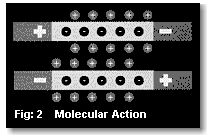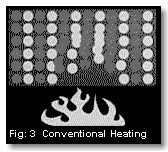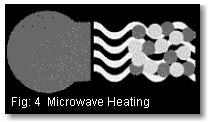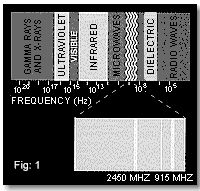|
 With
microwaves, no heat is applied per se. Instead a form of radio waves
(not nuclear nor ionizing radiation (see Fig.1) pass through the
material. The molecules in the material then act like miniature
magnets attempting to align themselves with the electrical field.
Under the influence of this high frequency alternating electrical
field, the particles oscillate about their axes creating intermolecular
friction which manifests itself as heat (see Fig. 2) With
microwaves, no heat is applied per se. Instead a form of radio waves
(not nuclear nor ionizing radiation (see Fig.1) pass through the
material. The molecules in the material then act like miniature
magnets attempting to align themselves with the electrical field.
Under the influence of this high frequency alternating electrical
field, the particles oscillate about their axes creating intermolecular
friction which manifests itself as heat (see Fig. 2)
What
are the advantages...
In conventional heating the heat source causes the
molecules to react from the surface toward the center (see Fig.
3) so that successive layers of molecules heat in turn. The product
surfaces may be in danger of over heating by the time heat penetrates
the material. Microwaves, however, produce a volume heating effect.
All molecules are set in action at the same time (see Fig. 4). It
also evens temperature gradients and offers other important benefits.
 Examples... Examples...
A producer of fat-free potato chips was awarded a
patent using a microwave system designed by Microdry making it possible
to produce a potato chip with the characteristics of a fried chip
without the use of oil.
The pre-drying
stage of ceramic filters used in smelting processes can be cut from
hours to minutes due to the ability of the microwave energy to penetrate
the material and force the moisture to the surface greatly reducing
time and energy consumption since the ovens operate at nearly 80%
efficiency.
A manufacturer
of building supplies replaced costly, less efficient equipment with
Microdrys' microwave equipment giving them a clear competitive edge
over their competitors while also allowing them to use less costly
raw materials and reduce the cutting of forests as well.
How
does an industrial microwave system differ from a home microwave
oven...
The home/restaurant batch-type ovens available to
date employ a relatively low power source as compared to the industrial
power source. This makes producing products beyond pilot scale levels
very labor intensive. In addition, the typical home oven is considerably
less efficient, up to 25% less, in converting electrical energy
into microwave energy. By comparison the industrial oven can be
designed as either a batch or as a continuous system with much higher
power and greatly increased throughputs, reducing the amount of
handling required. In addition, a forced air system can also be
employed, which greatly improves moisture removal in drying applications.
- The system
employs a high energy power source with long life.
- The system
has a unique internal protection feature (patented) that traps
stray microwaves, thus making the system completely safe to
operate. A new exclusive type of forced-air system used in conjunction
with microwave energy (patented) accelerates the removal of
moisture quickly and efficiently.
- A straight-through
conveyor assures uniform exposure to the microwaves.
- Because
of its high processing capacity, unit costs are much lower than
with the batch proces
Return
to the Articles Section
|













 When
microwave heating can be used - and is used properly - almost certainly
you will process more product in less time at lower cost. Throughout
history there has been one way to heat materials: apply heat to its
surface. About thirty years ago, industrial engineers began developing
microwave heating techniques that avoid some limitations of conventional
heating.
When
microwave heating can be used - and is used properly - almost certainly
you will process more product in less time at lower cost. Throughout
history there has been one way to heat materials: apply heat to its
surface. About thirty years ago, industrial engineers began developing
microwave heating techniques that avoid some limitations of conventional
heating.


 With
microwaves, no heat is applied per se. Instead a form of radio waves
(not nuclear nor ionizing radiation (see Fig.1) pass through the
material. The molecules in the material then act like miniature
magnets attempting to align themselves with the electrical field.
Under the influence of this high frequency alternating electrical
field, the particles oscillate about their axes creating intermolecular
friction which manifests itself as heat (see Fig. 2)
With
microwaves, no heat is applied per se. Instead a form of radio waves
(not nuclear nor ionizing radiation (see Fig.1) pass through the
material. The molecules in the material then act like miniature
magnets attempting to align themselves with the electrical field.
Under the influence of this high frequency alternating electrical
field, the particles oscillate about their axes creating intermolecular
friction which manifests itself as heat (see Fig. 2)
 Examples...
Examples...